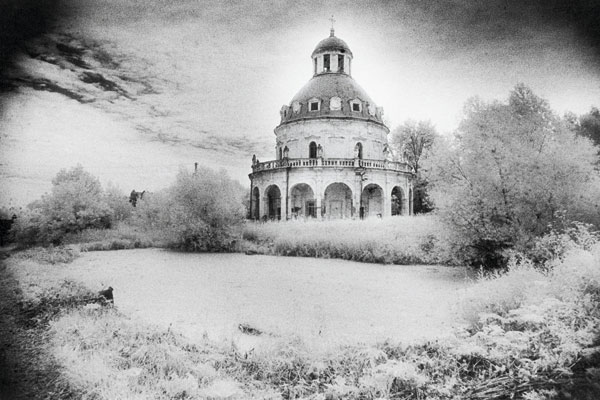Here are acres of desolate countryside, pockmarked by once great estates, ravaged by rot. Could it be much bleaker? Many aristocrats fled Russia during the Revolution. Even Tolstoy’s family were affected, and while his estate today survives intact, that of his daughter-in-law and countless other members of the 18th- and 19th-century nobility were left to ruin in overgrown fields across the entire country.
This book, part travelogue (Duncan McLaren), part photography book (the late Simon Marsden), restores these buildings and their monuments to our consciousness. Or at least what’s left of them. Many of the estates which lie between Moscow and St Petersburg have been eaten away by fire or scavengers. Some are simply lost. In Smolensk Province, an early 19th-century palace with stables, post office and music pavilion, all hidden in deep green forest, even eluded the SS during the second world war.
Thuggish greenery may wreck the foundations of houses, but it does look pretty among the stonework. In the tradition of the French painter Nicolas Poussin, Simon Marsden has captured that dichotomy between beauty and decay perfectly in his shot of the Taraskovo Estate. Lying in Kashira, near Moscow, it was here that Tolstoy’s daughter-in-law Alexandra Glebov spent her summers.
If only it was merely overgrown. The greatest tragedy of the Glebov home is that it wasn’t until the late 1990s that its main house and exquisite parquet floors and panels were finally destroyed — by vandals. McLaren writes: ‘There will not be another chapter here; nature has won.’ Nature, or nature ruled by man?
Russia: A World Apart is tinged with a sadness worthy of Anna Karenina — which is hardly surprising, given that it was Tolstoy’s descendant Tania Illingworth (née Tolstoy-Miloslavsky) who organised its authors’ trip from ‘one dead or dying village after another, whose vandalised churches are now the refuge of owls and pigeons, their crumbling cupolas symbolic of a broken age’.
But what the book leaves out is exactly why these magnificent estates came to such a sorry end. All detail about the scenarios which resulted in their abandonment, or the human stories of those that once owned them, are subsumed by the authors’ focus on the empty carcasses that they became. The lacunae are left to speak for themselves.
Just a handful of human shadows emerge from this eerie silence: a wife installed by her husband at Znamenskoe Rayok, the ‘Russian Colosseum’, a safe distance from the seductions of society; Catherine the Great, who visited; and the many sufferers interned in palaces which have become asylums and sanatoriums, the most architecturally stunning of which is Bykovo, Moscow Region, an Italianate structure with a gorgeous line of buxom caryatids.
Looking at these settings is like contemplating the aftermath of War and Peace. It is as intriguing as it is depressing, beautiful where it simply should not be. Russia: A World Apart is a fine momento mori of a grandeur tragically lost.






Comments